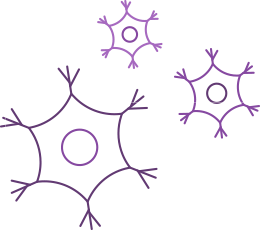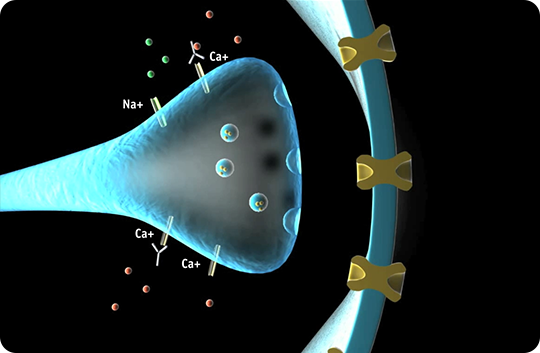
What is LEMS?
LEMS is an autoimmune disorder of the neuromuscular junction, the site where nerve cells communicate with muscle cells. It occurs when the body makes antibodies that attack the ends of the nerves and interfere with signals that tell the muscles what to do.1,2
Types of LEMS
There are two different types of LEMS:
cancer-associated LEMS and non-cancer-associated LEMS.

Cancer-associated LEMS
(also called paraneoplastic LEMS)
About half of all cases of LEMS are associated with cancer, usually a smoking-related cancer called small-cell lung cancer. This type of LEMS generally starts later in life (around 60 years of age) and is more common in men than in women.2,3 It is thought to occur when the body makes antibodies against the cancer that then mistakenly attack nerve cells.2,4

Non-cancer-associated LEMS
(also called non-paraneoplastic LEMS)
Non-cancer-associated LEMS occurs in people of all ages, although as with cancer-associated LEMS, it is more common in older people. This form of LEMS generally affects men and women equally.2,3 It is not currently known what triggers the immune system to attack the nerves, but people with non-cancer-associated LEMS may have genetic characteristics that make them more susceptible to autoimmune diseases.2

Causes of LEMS
LEMS is caused by autoantibodies, which are antibodies produced by the body’s immune system that attack the body’s tissues. In LEMS, these antibodies attack the neuromuscular junction and disrupt the release of neurotransmitters, chemical messengers that allow nerves and muscles to communicate, resulting in muscle weakness.4
Signs & symptoms
LEMS can affect many different parts of the body. The symptoms of LEMS usually come on slowly, starting with general fatigue, muscle weakness (particularly in the legs) and dry mouth.3–5 The muscle weakness may get worse over time and usually spreads downwards from the hips and thighs to the feet, and upwards from the lower body to the head.2 These symptoms can make it difficult to get up from a sitting position or climb stairs, and may worsen after exercise or in hot conditions.6


Eyes4
- Double vision
- Drooping eyelids
- Slow pupil reactions (tonic pupils)
Head & neck4,5
- Dry mouth
- Metallic taste
- Slurred speech
- Difficulty in swallowing and chewing
- Weakness in the face, jaw, palate and neck
- Weak voice
- Head lolling
- Lightheadedness
Arms4
- Weakness in the arms
- Impaired sweating
- Poor reflexes
Trunk4
- Respiratory muscle weakness
Urogenital system4
- Impotence
- Poor bladder control
Gastrointestinal tract4
- Constipation
- Poor bowel control
Legs4
- Weakness in the legs
- Muscle pain and stiffness
1. BMJ Best Practice. Lambert-Eaton myasthenic syndrome; definition http://bestpractice.bmj.com/best-practice/monograph/1052/basics/definition.html (accessed April 2021). 2. Titulaer MJ, Lang B, Verschuuren JJGM. Lancet Neurol 2011;10:1098–1107. 3. Titulaer MJ and Verschuuren JJGM. Ann N Y Acad Sci 2008;1132:129–134. 4. Seneviratne U and de Silva R. Postgrad Med J 1999;75:516–520. 5. Sanders DB. Ann NY Acad Sci 2003;998:500–508. 6. Mareska M and Gutmann L. Semin Neurol 2004;24(2):149–153.


